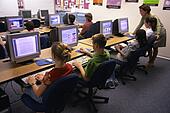Additionally it depends on how computers are incorporated into the early childhood curriculum (Haugland, 2000). Te Whariki believe that children develop familiarity with properties and character of the materials and technology used in the creative and expressive arts (Ministry of Education, 1996). As an early childhood educator, I believe that children should be expose in creative activity such as painting, music, drawing or collage as their way of expressing themselves. Documenting children's work with a nice photo done by a digital camera is so easy that the children can take turn taking photo of themselves.
Most experts believe computers are not developmentally appropriate for children under the age of three (Elkind, 1998; Haugland, 1999; NAEYC, 1996). However, these same experts believe children three years old and older can begin to effectively explore and use computers. Surely, many of the factors that make computers developmentally inappropriate for children under age three are also present in older children: active learners busily manipulating a wide variety of objects…and in the process of learning about themselves and their environment” (Haugland, 1999, p. 26).
Te Whariki affirms that children develop spatial understandings, including an awareness of how two-and three dimentional objects can be fitted together and moved in space and ways in which spatial information can be represented, such as in maps, diagrams,photographs and drawings (Ministry of Education, 1996).
To evaluate whether computers are developmentally appropriate for children over age three, we need to determine the developmental needs of these children. Children this age are developmentally within Piaget’s preoperational stage. This means they are concrete learners who are very interested in using newly learned symbolic representation - speaking, writing, drawing (including maps and geometric figures) and using numbers. Further, children this age are extremely active and movable. They often have difficulty sitting still; they need frequent changes in learning modalities; and they want a variety of physical experiences involving dance, physical play, climbing and sports.
Preoperational children are also are continuing their mastery of language, and exploring various facets of social behavior.Howard Gardner has shown that young children exhibit a diversity of learning styles, and that the optimum way for many children to learn is not the traditional teacher-directed, verbal approach (
Clearly many of these developmental needs match up well with appropriate use of technology in the centre, especially exploration, manipulation of symbolic representation, matching alternative learning styles, and quickly changing learning modalities that individual children can control and pace to meet their individual needs. It is also a very powerful tool for children with specific learning disabilities.
If a goal of the literacy curricula for a certain age child is to learn to write personal journals, then the computer can naturally support that through writing software, digital cameras, and other methods.
If computers are not fully integrated into the overall curriculum, they can actually negatively impact children’s creativity (Haugland, 1997). To integrate computers effectively, these steps must occur:
select developmentally appropriate software; select developmentally appropriate websites and Integrate computer resources in the centre.
select developmentally appropriate software; select developmentally appropriate websites and Integrate computer resources in the centre.
So there, technology is here to stay its changing fast and theres nothing we can do about it, but to welcome and learn it......... FAST




References:




References:
Elkind, D. (1998). Computers for infants and young children. Child Care Information Exchange. 123, 44-46.
Haugland, S. W. (2000). Early childhood classrooms in the 21st century: Using computers to maximize learning. Young Children, 55 (1), 12-18.
Haugland, S. W. (1999). What role should technology play in young children’s learning? Young Children, 54 (9), 26- 30)..
Ministry of Education. (1996) Te whāriki, he whāriki mātauranga mō ngā Mokopuna o Aotearoa: Early childhood curriculum. Wellington, New Zealand: Learning Media.
NAEYC (1996). Position statement on technology and young children - ages three through eight. Young Children, 51 (6), 11-16.
Haugland, S. W. (1997). The developmental scale of software. Cape Girardeau, MO: K.I.D.S. & Computers.
Gardner, H. (1987). Frames of mind: The theory of multiple intelligences. New York: Basic.
Hi Annie
ReplyDeleteYou have raised an interesting issue about whether or not it is beneficial to use computers with children under 3. I know that my daughter (at just over 2) is very interested when I am on the computer and likes to look at photos of herself. Another thing we do together is look up video clips of her favourite characters from books and TV programmes. From your experience and the reading you have done, what do you personally think?
Kia Ora Tamar Thanks for posting your comment, I have been reading articles about the effect of technology in children and so far the research reading from the American Academy of Pediatrics suggest that children under two years old should not be watching or playing with any technology, because it can cause strabismus (lazy eye).
ReplyDeleteWe know from other studies that children are affected by content and by advertising, but there is still no strong evidence about the effects of technology on the development of young children…positive effects or negative effects. The research is emerging…but not definitive.
As to personal opinion, I don’t think there’s an adverse effect for children under twos to be looking or holding on some technologies in the centre or at home for that matter for as long as adults are supervising them and only for short period.
Children that age are just particularly curious on what they see and everything they grab hold becomes toy to them.
For infants and toddlers, the focus is on exploration and manipulation…learning what the equipment will do and how they can control it for their own purposes (which might include putting it in their mouths….or banging it on a table.) We have to think about whether the tools are safe for children of this age…and whether the materials will be safe in their hands.
The NAEYC position statement on children and technology can help to guide early childhood professionals in making informed decisions about the how and when to integrate technology into the early childhood classroom (Rideout, V. J., Vandewater, E. A., & Wartella, E.A. 2003).
By Anniesland on Exposing children to technology is it good/bad? at 00:53
Emily Ng has left a new comment on your post "Exposing children to technology is it good/bad?":
ReplyDeleteComputer education in most childhood settings is not predominant in the curriculum. It plays only a small part of it. A valid concern is the appropriateness of the software made accessible to the young children. On the other hand, not to allow access to the use of the computer would deprive the children of computer hands-on skills and the information that can be obtained from surfing the net. To allay concerns about access to undesirable information, teachers can look into the use of access blocks in addition to direct supervision over the children using the computer at the centre.
We know that when used appropriately, information technology can enhance children’s cognitive and social abilities (Catron, 2003). Moreover, it is the aspiration of Te Whāriki: He whāriki mātauranga mō ngā mokopuna o Aotearoa that “learners in ECE services should have....enhanced learning opportunities through the meaningful use of ICT [and also to] broaden their horizons by exploring the wider world” (Ministry of Education, 2009, p.2). The computer is not replacing any part of the curriculum but the computer is to be integrated into the existing curriculum. Any issues of associated risks could be dealt with by implementing a cyber safety programme, which is the safe and responsible use of ICT (Netsafe, 2008).
We should be guided by Bruner’s (1977) statement that “learning should not only take us somewhere; it should allow us later to go further more easily” (as cited in Bruce, 2005, p. 35). Essentially it means we have to enable our children to progress and this can be assisted by the controlled and appropriate use of the computer in early childhood education.
Reference List
Bruce, T. (2005). Early childhood education. (3rd ed.). London, United Kingdom: Hodder Arnold.
Catron, C. E., & Allen, J. (2003). Early childhood curriculum: A creative play model. (3rd ed.). New Jersey, United States of America: Merrill Prentice Hall.
Ministry of Education. (2009). Information and Communication Technology (ICT). Kei tua o te pae: Assessment for learning: Early childhood exemplars (20). Wellington, New Zealand: Learning Media.
Netsafe. (n.d.). Netsafe Kit for ECE [Booklet]. New Zealand: Author.